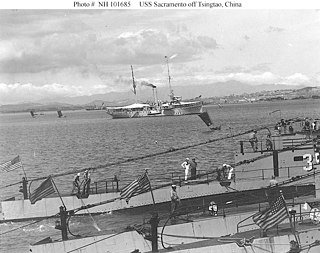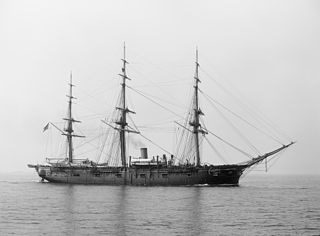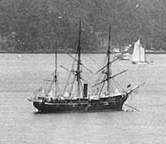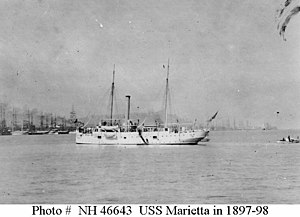
USS Dolphin (PG-24) was a gunboat/dispatch vessel; the fourth ship of the United States Navy to share the name. Dolphin's keel was laid down by Delaware River Iron Ship Building and Engine Works of Chester, Pennsylvania. She was launched on 12 April 1884, with Captain George Dewey in command, and commissioned on 8 December 1885 with Captain R. W. Meade in command. Dolphin was the first Navy ship to fly the flag of the president of the United States during President Chester A. Arthur's administration, and the second Navy ship to serve as a presidential yacht.

USS Raleigh (C-8) was a United States Navy protected cruiser of the Cincinnati class, commissioned in 1894 and in periodic service until 1919.

The second USS Sacramento (PG-19) was a gunboat in the United States Navy.

USS Helena (PG-9) was a Wilmington-class gunboat of the United States Navy. She participated in the Spanish–American War, and served in the Far East for many years. The (PG-9) was the first of five Navy vessels named after the capital city of Montana.

USS Breckinridge (DD–148) was a Wickes-class destroyer in the United States Navy during World War II, later reclassified as AG-112. She was named for Ensign Joseph Breckinridge.

The second USS Marblehead (C-11/PG-27) was a Montgomery-class unprotected cruiser in the United States Navy, authorized in the naval appropriations bill of September 7, 1888. Marblehead served in the Spanish–American War and World War I, and was the last ship of her class in service.

The first USS Lancaster was a screw sloop-of-war in the United States Navy during the American Civil War through the Spanish–American War.

USS Fox (DD-234/AG-85) was a Clemson-class destroyer in the United States Navy during World War II. She was the fourth ship named for Gustavus Vasa Fox, Assistant Secretary of the Navy during the Civil War.

|} The first USS Tuscarora was a Mohican-class sloop of war in the United States Navy during the American Civil War. Tuscarora was laid down on 27 June 1861 at Philadelphia, Pennsylvania, by Merrick & Sons; launched on 24 August 1861; sponsored by Miss Margaret Lardner; and commissioned on 5 December 1861, Commander Tunis A. M. Craven in command.

USS Nashville (PG-7), a gunboat, was the only ship of its class. It was the first of three ships of the United States Navy to hold the name Nashville.

USS Paducah (PG-18) was a Dubuque-class gunboat acquired by the US Navy prior to World War I. Her task was to patrol, escort, and protect Navy ships.

USS Dubuque (PG-17) was a United States Navy patrol combatant ship that served in both World War I and World War II. She was named for Dubuque, Iowa.

USS Wheeling (PG-14) was a Wheeling-class gunboat acquired by the U.S. Navy in 1897. She served as a gunboat during the Spanish–American War as well as a convoy escort during World War I. As IX-28 she also served as a schoolship for the training of Naval Reservists, and, at the end of World War II, just before being struck from the Navy records, she was temporarily assigned as a barracks ship for torpedo boat crews.

USS Leonidas (AD-7) was a destroyer tender, the lone ship in her class, named for Leonidas I, and the second United States naval vessel to bear the name.

The first USS Machias (PG-5), a schooner-rigged gunboat, was laid down in February 1891 by Bath Iron Works, Bath, Maine. She was launched on 8 December 1891. She was sponsored by Miss Ethel Hyde, daughter of President Hyde of Bath Iron Works and commissioned at Portsmouth Navy Yard, Kittery, Maine, 20 July 1893, Commander Charles J. Train in command.

USS Wilmington (PG-8) was the lead ship in a class of two United States Navy gunboats. She was laid down on 8 October 1894 at Newport News, Virginia, by the Newport News Shipbuilding Company; launched on 19 October 1895; sponsored by Mrs. Anne B. Gray; and commissioned on 13 May 1897.

USS Topeka (PG-35) was a gunboat of the United States Navy.
USS Wyandotte, originally USS Western Port, was a steamer acquired by the Navy as a gunboat for the Paraguay expedition in 1858. When the crisis of the American Civil War occurred, she operated in support of the Union Navy blockade of Confederate waterways.

As part of the Secretary of the Navy George M. Robeson's plans to overhaul and modernize ships of the Navy, the first USS Swatara was taken to the New York Navy Yard in 1872, ostensibly for "repairs". In fact, the "repairs" constituted construction of a new ship, for Swatara was given a new hull and unused machinery which had been in storage since 1865. Embodying only certain fittings and equipment from the first ship, the second Swatara was launched on 17 September 1873 at the New York Navy Yard and commissioned on 11 May 1874, Capt. Ralph Chandler in command.

The fourth USS Scorpion was a steam yacht in commission in the United States Navy from 1898 to 1899, 1899 to 1901, and 1902 to 1927.



















